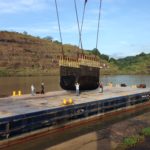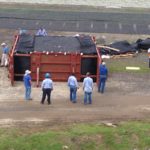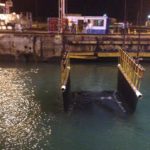Company:
TenCate Geosynthetics Americas Pendergrass, GA
Project Details
Fabric 1
Geotube®
Producer:
TenCate Geosynthetics
Engineer Name 1
Antonio Abrego
Engineer Company 1
Panama Canal Authority
Design Name
Antonio Abrego
Design Company
Panama Canal Authority
Fabrication Company
TenCate Geosynthetics
Graphics Company
TenCate Geosynthetics
Project Manager Name
Antonio Abrego
Project Manager Company
Panama Canal Authority
Installation Company
Panama Canal Maintenance and Engineering Division
Please describe the project specifications
a. Fabricate up to 100 Geobag units (5m wide x 5m long x 2m high) with a volume of 50 m3 each. The geotextile used to fabricate the Geobags must have a tensile strength of 200 x 200 kN/m and seam strengths of 160 kN/m.
b. Provide a friction lifting harness grid for each Geobag unit that has a 10.0 factor of safety against rupture and pull-out.
9,000 m2 of geotextile and 15,500 m2 of geogrid
What was the purpose of this project? What did the client request?
a. The purpose of the project of the project was install Geobag units to form coffer dams underneath 20m of water along the leading edge of the bottom slab and along the base of the dividing wall of the Gatun Locks.
b. The Geobag coffer dams were to hold the liquid concrete that would be pumped under the slab and the base of the dividing wall to fill the holes that had eroded under the Gatun Locks over the past 100 years of operation of the Panama Canal.
What is unique or complex about the project?
The unique complexity and challenges of the project were:
a. Only one set of the Gatun Locks at the Panama Canal could not be shut down at one time during the repair and for no more than 12 hours at a time.
b. The 50 m3 Geobag units had to be filled off-site, lifted onto a barge by the 300 ton Titan Crane, transported to the Gatun Locks immediately before placement, and placed underneath 20 meters of water on the bottom of the canal locks by the Titan crane.
c. Using the friction geogrid lifting harness, the Titan Crane would lift and place, one at a time using GPS positioning, the 50 m3 Geobag units to form the underwater coffer dam
d. Once the placement was confirmed for each Geobag by divers, the crane would place the next Geobag unit.
e. After all of the Geobag units were in place forming the coffer dam, concrete was pumped behind the coffer dam and underneath the concrete slab of the Gatun Locks bottom slab or the base of the dividing wall to fill the erosion voids.
What were the results of the project?
a. All Geobag units were filled, lifted to the transfer barge, and placed in position to form the coffer dam.
b. The Geobag coffer dam contained all of the concrete pumped under the canal entry bottom slab and base of the dividing wall exactly as planned.
c. Because of the success of the project, The Panama Canal Maintenance and Engineering Department has chosen the Geobag method as a standard practice to perform the same erosion protection task at all of the Panama Canal Locks.
Content is submitted by the participant. IFAI is not responsible for the content descriptions of the IAA award winners.



 TEXTILES.ORG
TEXTILES.ORG





